China stunned the world’s financial markets on Wednesday by devaluing its currency for a second consecutive day, triggering fears its economy is in worse shape than investors believed.
The move sent fresh shockwaves through global markets, pushing shares sharply lower and sending commodity prices further into reverse as traders feared the move could also ignite a currency war that would destabilise the world economy.
There were widespread losses on stock exchanges in Asia, and in Europe markets suffered falls of about 1%, with the FTSE 100 in London tumbling almost 2% at one stage before settling at 6571, down 1.4%.
The Chinese authorities have acted after a string of poor economic figures showed that previous efforts to boost exports and growth against the headwind of an overvalued currency had failed.
A drop of 6.6% in car sales in July followed data at the weekend showing an 8% fall in exports and slowing business investment growth in the same month. A survey tracking China’s factory output for July also missed expectations, coming in at 6% year-on-year growth instead of the 6.6% expected.
One financial analyst said the devaluation, which pushed the yuan to a four-year low, heralded a tidal wave of cheap goods from Asia as other south east Asian countries followed suit.
Albert Edwards, analyst at Societe Generale, said the yuan had become overvalued against the dollar in recent years and was unsustainably high relative to other major currencies.
The Chinese currency hit a four-year low on Wednesday after the People’s Bank of China set the yuan’s daily midpoint even weaker than in Tuesday’s devaluation.
Unlike the pound and other major currencies, the yuan’s value is determined each day by the People’s Bank based on movements the previous day. As part of the devaluation, the authorities said they would widen the criteria to include more market information, allowing the currency to rise or fall more rapidly than before.
The central bank sought to reassure financial markets that it was not embarking on a steady depreciation.
“Looking at the international and domestic economic situation, currently there is no basis for a sustained depreciation trend for the yuan,” it said.
A spokesman said the downward movement of the currency was a result of a project to liberalise its management and not a deliberate attempt to drive down its value.
But with the bank having said on Tuesday that that day’s action was a “one-off depreciation”, the rapid two-day drop in the value of the currency of about 4% dealt a blow to investors. They fear a prolonged currency war that could damage world trade should the US and Japan retaliate and drive down the value of the dollar and yen.
Oil prices remained below $50 a barrel, down from more than $110 a barrel last summer when the slowdown in China first became apparent. The prices of key industrial and construction metals – nickel, copper and aluminium – hit six-year lows.
Rajeev De Mello, head of Asian fixed income at Schroders in Singapore, said: “While it is too early to say whether this is the beginning of a sustained devaluation of the yuan, other central banks may be forced to follow suit and that may trigger a fresh round of currency weakening around the emerging world.”
The two devaluations come after a run of poor economic data and have raised suspicions that China is embarking on a longer-term slide in the exchange rate.
A cheaper yuan will help Chinese exports by making them less expensive on overseas markets.
The first move on Tuesday was the biggest one-day fall in the yuan since a massive devaluation in 1994. On Wednesday the yuan fell to 6.43 against the dollar, its weakest point since August 2011. The currency fared worse in offshore trade, touching 6.57.
The International Monetary Fund said China’s move to make the yuan more responsive to market forces appeared to be a welcome step and that Beijing should aim to achieve an effectively floating exchange rate within two to three years.
Beijing has been lobbying the IMF to include the yuan in its basket of reserve currencies, known as Special Drawing Rights, which it uses to lend to sovereign borrowers. This would mark a major step in the international use of the Chinese currency.
“Greater exchange rate flexibility is important for China as it strives to give market forces a decisive role in the economy and is rapidly integrating into global financial markets,” an IMF spokesperson said.
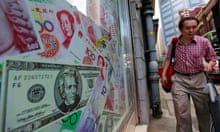
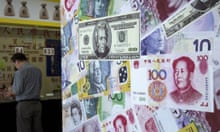
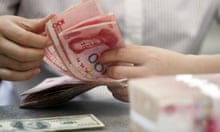
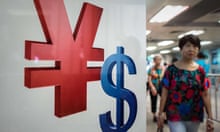


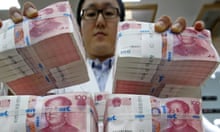
Comments (…)
Sign in or create your Guardian account to join the discussion